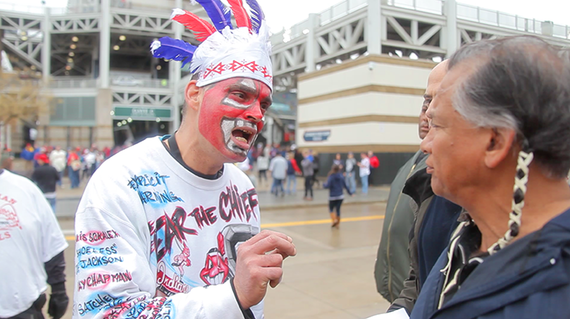Starting with a dig at those who would dare question the polling data in support of Native American mascots, last Friday, Naomi Shaefer Riley published commentary in the Wall Street Journal that managed to dismiss Native American voices while simultaneously patronizing our experiences.
Her approach is nothing new, but noteworthy in that she actually bothered to research a few Native American perspectives before casting them aside.
Riley's column was based upon a book written by Jennifer Guiliano, titled Indian Spectacle. The book covers the history of Native American mascots, beginning in the 1920s. Guiliano posited that Native mascots were a method to lure in college goers. These mascots were an exciting addition to football games that represented both the savage, capable of barely restrained violence, as well the noble savage, a reminder of the fighting spirit extinguished by America.
Here is where Riley goes off the rails.
She buys into the concept of noble savage and goes on to cite the Boy Scouts use of Native imagery to "instill character." Riley appears to be entirely unaware of the harms tied to the relegation of existing peoples to a one-size-fits-all historical romantic caricature.
The noble savage is a white-washed representation of American exceptionalism, a mythical figure who teaches school children that Manifest Destiny was a patriotic act that ended the tale of Native America for the onset of a new and better world. It overlooks the genocide endured by Native Americans, the theft of children, lands, and cultures that still occur today.
Riley's assessment bypasses the fundamental issue of Native American nations continuing to exist. Her perceived positives of physical prowess, bravery, and resistance uphold the narrative of Native Americans as conquered people of the past. Native mascots allow society to ignore the very real plight of indigenous peoples today, and results in all-too-frequent questions like "Do you live in a tipi? You're Native? Cool, let me just casually claim your experience, I'm part Cherokee on my grandmother's side."
She goes on to cite the National Congress of American Indians, which published a report on Native mascots last fall. Riley expresses doubt at NCAI "claims" that Native mascots harm the self-esteem of Native American children and outright indignation at linking lowered self-worth to suicide.
Perhaps a foray into footnotes would be helpful, as the NCAI report cites several psychological studies, including a 2005 study adopted by the American Psychological Association that empirically demonstrate the harm of mascots to Native children. As suicide is the second leading cause of death for Native Americans ages 15-24, it is harsh at best to denounce an organization for highlighting a harm to at-risk children that is easily removed.
Riley's disregard of Native American voices is not surprising, however. Her tenure as a blogger at the Chronicle of Higher Education ended with her publication of "The Most Persuasive Case for Eliminating Black Studies? Read the Dissertations."
Her post dissected several student dissertations, in one instance openly scoffing at the notion that Clarence Thomas assaulted the civil rights legacy. Clarence Thomas is well known for his opposition to affirmative action, a product of the black civil rights movement that has benefitted scholars of color. Apparently these connections are impossible to make, however.
Riley concluded with a reference to problems plaguing the black community, like high incarceration rates and low graduation rates. The "white man" plays no role in these statistics, in Riley's assessment. In essence, institutional racism has little to no impact on communities of color, and it can be entirely bifurcated from "real issues".
True to form, Riley ended her discussion of Native American mascots by noting high rates of poverty, alcoholism, and gang involvement. In her opinion, a racial caricature on the side of a jersey couldn't possibly "alter your sense of yourself."
One wonders if she would support the reemergence of blackface as a celebrated source of entertainment. It would appear the ongoing dehumanization of an entire race of people plays no role in the perception and experience of Native Americans. I, for one, beg to differ.
In Washington, D.C., the effects that ignorance of modern Native America has on our bottom line are on full display. What Congress would possibly grant tribal nations the right to prosecute non-Native offenders when Native peoples are still viewed as savages from a past era?
References to tribal justice systems as "kangaroo courts" and opposition to allowing tribes run their own affairs, such as managing federal grants for suicide prevention, persist throughout the bureaucracy. Excessive oversight bleeds what little appropriations tribal governments receive, while the federal declination rate to prosecute violent crimes on reservations hovers around 50 percent.
Riley's article ends with a note that she is currently writing a book on Native American culture. I suggest she familiarize herself a bit more with the Native American experience and determine whether being a noble savage openly caricatured in the modern public sphere is a "positive."
*Note: This is a cross-post of an article originally published in Indian Country Today
